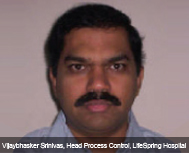
CIOTechOutlook >> Magazine >> June - 2013 issue
Technology: The Life Blood for Hospitals
By
 LifeSpring Hospitals Private Ltd. is an expanding chain of maternity hospitals that provide health care to lower-income women and children in India.
LifeSpring Hospitals Private Ltd. is an expanding chain of maternity hospitals that provide health care to lower-income women and children in India.Healthcare then and now
Healthcare sector has undergone tremendous transformation in the last 15 years. Then, patients preferred family physicians and the treatment had more personal touch. Now, fame of the doctor and hospital plays a major role and the treatment is more professional. The clinical decision relies more on diagnostics, flash cards and other memory aids. Digital records have replaced unofficial biographer and is more emphasised on availability at the time of need to the persons who need it.
Doctors can get multiple advice over net and tele-radiology as remote clinics have made it possible. Middle tier hospitals that can support provision of tertiary care have come up and the bearing costs of treatment have the growing support through health insurance. Mobile devices, large storages, BYOD and easy connectivity have largely impacted the healthcare sector. Simultaneous communication with multiple stakeholders is now possible on real-time.
Challenges
Right information, right service providers, right decision aids, right drug, and at right time – these can all be aided by use of technology. Customer registrations and tracking appointments is essential for business planning and resource scheduling in hospitals. It is also important that employees responsible to use the software are trained in using the technology. The quantum of data that is available is growing fast and the speed at which the data can be accessed is important. Hence, being tech-savvy is the life blood for the healthcare sector.
The major challenges that LifeSpring faced was choosing between various technologies. Being a cost efficient model – the challenge was to look for more value for money packages rather than high end packages. Ensuring the right requirements – neither too less functionality nor too much functionality was another challenge for us. We overcame the challenges by recourse to a high powered committee, and regular monitoring of the use by the CEO.
The CIOs Requisites
Solution providers are focussed on large hospitals, digitizing medical data, and providing support for health and insurance claims. The solutions capture as large a data as possible. This needs that someone trained in using computer keyboard is required at various stages of using the system. The solution providers can better meet the needs of the CIOs by (a) ensuring that only the data relevant at each stage is captured, and (b) monitoring systems that bring out any deviations on a real time basis to control the errors that crop into the system.
Vision
We look to keep providing sustainable affordable quality healthcare to the target segment. Stabilize present operations and expand the model to places where such healthcare is absent! A solution that integrates operations and accounts is customized for operational and control requirements of our hospitals and that can be used in low resource settings. The solution should be robust enough to enable us to discontinue IT departments. In other words, IT should enable implementation, control and refinement of processes. IT should never require the processes to be changed to suit it. The system should be so designed that it can be expanded to cover other parts of the organization and ultimately become an enterprise resource planning and monitoring software.
CXO Insights
Top Five Customer Data Management And Security...
By Deepak Gupta, CTO and Co-Founder, LoginRadius
AI Integration in Multi-Cloud and Edge...
By FaizShakir, VP & Managing Director – Sales, Nutanix
Bernard Golden Five Rules for Today's ALM




